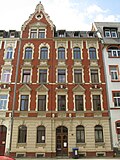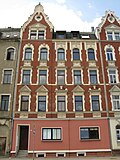List of cultural monuments in the Hofer Vorstadt (Plauen)
The list of cultural monuments in the Hofer Vorstadt includes the cultural monuments of the Plauen district of Hofer Vorstadt , which were recorded by the State Office for the Preservation of Monuments until January 2020 (excluding archaeological cultural monuments). The notes are to be observed.
This list is a subset of the list of cultural monuments in Plauen .
List of cultural monuments in the Hof suburb
| image | designation | location | Dating | description | ID |
|---|---|---|---|---|---|
 |
Apartment building in closed development | Am Unteren Bahnhof 15 (map) |
1903 | Historic building of the city expansion, architectural significance. Four-storey plastered clinker brick building with five axes, ground floor with plaster grooves, central entrance, segment arch openings (these are also on the third floor) with heads as keystones, the three upper floors with red clinker brick, floral plaster and stucco decorations on the window frames and influenced by Art Nouveau - crowning (first floor triangular gables, tendril fields, third floor lion heads), above the two left axes roof house with tail gable and oculus, three small standing dormers, design matches with neighboring buildings number 16 and 17. |
09246591 |
 |
Apartment building in closed development | Am Unteren Bahnhof 16 (map) |
1903 | Originally with a shop, a historicizing, slightly modified building typical of the time, of architectural significance. Four-storey plastered clinker brick building with five axes, first floor probably originally with plaster grooves, now smoothed, side entrance, segment arch openings (these also on the third floor) with heads as keystones, the three upper floors with red clinker brick, floral plaster stucco influenced by Art Nouveau -Ornaments of the window frames and crowning (first floor triangular gable, tendril fields, third floor lion heads), above the two left axes roof house with tail gable and oculus, three small standing dormer windows, design matches with neighboring building number 15 and number 17. |
09246590 |
 |
Apartment building in closed development | Am Unteren Bahnhof 17 (map) |
1903 | Originally with a shop, historicizing construction of the city expansion, despite the changed ground floor of architectural significance. Four-storey plastered clinker brick building with five axes, the first floor probably originally with plaster grooves, now heavily changed, side entrance, the three upper floors with red brick, floral plaster and stucco decorations of the window frames and crownings influenced by Art Nouveau (first floor triangular gable, Tendril fields, third floor lion heads), above the two left axes roof house with tail gable and oculus, three small standing dormers, design matches with neighboring buildings number 15 and number 16. |
09246589 |
 |
Water tower and signal box of the lower Plauen station | At the lower freight yard (map) |
1913 | Operating facilities of the lower Plauen station on the Gera Süd – Weischlitz line (Elstertalbahn), of significance in terms of technology and railway history. Water tower on a circular floor plan, water tank with a larger area, closure by a conical roof with lantern, unchanged as only a few specimens here.
The water tower at the lower station in Plauen was built in 1913 by the Carl Grundwald company from Dresden. From 1916 it supplied the steam locomotives on the Gera-Weischlitz line, which was opened in 1875 by the Saxon-Thuringian Railway Company, with service water. It is an unadorned, plastered brick building whose circular tower shaft tapers conically. A simple belt cornice marks the transition to the far cantilevered tower head, which contains the steel water tank. The tower is closed off by a pointed conical roof with a ventilation hood. The former water level indicator is fragmentary preserved on the track side. As a testimony to the rapidly developing railway system at the end of the 19th and beginning of the 20th century, the water tower, built purely according to functionalist aspects, completely unadorned and preserved in its original condition, is of historical railway value. |
09246587 |
 More pictures |
VOMAG railway bridge (so-called armored bridge ) | Holbeinstrasse (map) |
1942 | Structurally remarkable bridge structure, with war damage from bombs and projectiles as a result of the air raids in 1945, is one of the last testimonies of the machine factory that was once important for Plauen and is also a unique historical testimony to German armaments production and the air raids on Plauen during the Second World War, of great historical importance as well as of high documentation and memory value.
|
09299716 |
 |
Apartment building in closed development | Messbacher Strasse 19 (map) |
Around 1900 | Typical clinker brick building of the city expansion, relevance to the history of the building. Four-storey red brick building with six axes, the high ground floor with base zone is visually demarcated by an ornamented plaster cornice, segment arch openings on the ground floor, side entrance gate. The three upper floors each have a domed window above the entrance axis. All windows with a straight lintel. The first floor is highlighted by stucco crowning, the two floors above have a flatter relief. In Berlin roof structure of the postwar period. |
09247341 |
 |
Tram cars | Wiesenstrasse 24 (map) |
1966 (railcar); 1969 (sidecar) | Class 79 and sidecar class 28 of VEB Waggonbau Gotha, location is the tram depot of the Plauen tram, significant in terms of traffic history.
|
09247470 |
Former monuments
| image | designation | location | Dating | description | ID |
|---|---|---|---|---|---|
 |
Residential building in closed development | Am Unteren Bahnhof 4 (map) |
Around 1900 | Removed from the list of monuments after 2009 |
|
 |
Residential house in open development | Brüderstraße 2 (map) |
Around 1900 | Removed from the list of monuments after 2009 |
|
Remarks
- This list is not suitable for deriving binding statements on the monument status of an object. As far as a legally binding determination of the listed property of an object is desired, the owner can apply to the responsible lower monument protection authority for a notice.
- The official list of cultural monuments is never closed. It is permanently changed through clarifications, new additions or deletions. A transfer of such changes to this list is not guaranteed at the moment.
- The monument quality of an object does not depend on its entry in this or the official list. Objects that are not listed can also be monuments.
- Basically, the property of a monument extends to the substance and appearance as a whole, including the interior. Deviating applies if only parts are expressly protected (e.g. the facade).
Detailed memorial texts
-
↑ Armored
bridge : The railway bridge of the Vogtland machine factory, made of strong steel plates and sheets, was used to transfer heavy, tank-laden railway wagons across the White Elster in the direction of the lower station in Plauen and was therefore given the name "Armored Bridge". VOMAG, originally a Plauen-based company known around the world for the manufacture of embroidery machines, also took up tank destroyers during the Second World War after producing vehicles for the Wehrmacht. The assembly hall, newly built on the left side of the Elster River between 1941 and 1943, was connected to the railway network by means of the present railway bridge. The construction, which is extremely stable due to the heavy loads, - a riveted steel solid wall girder trough bridge with a concrete pillar - survived several targeted air raids in 1945. Bomb hits and bullet holes can still be seen on the structure today. The armored bridge is one of the last structural testimonies for VOMAG and is therefore not only of structural and technical historical importance, but also of industrial history due to its special construction due to the great weight of the tanks to be transferred. In addition, the bomb and projectile hits still visible, the bridge structure becomes an impressive testimony to the air raids on Plauen and is therefore of great historical importance as well as of high documentation and memory value.
swell
- Monument map of Saxony. Retrieved January 5, 2020 .
- Geoportal of the Vogtlandkreis. Retrieved January 5, 2020 .
- List of listed monuments from 2009 on plauen.de. (PDF file; 156 kB) Retrieved January 5, 2020 .
